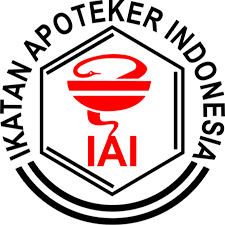Optimization of Soursop (Annona muricata L.) Leaf Extract in Nanoemulgel and Antiacnes Activity Test Against Propionibacterium acnes, Staphylococcus aureus, Staphylococcus epidermidis Bacteria
Hanif Fibiana Asyhari(1), Kibedi B Cabral(2), Erindyah R Wikantyasning(3*)(1) Master of Pharmacy, Universitas Muhammadiyah Surakarta
(2) Department of Biochemistry, Kabale University School of Medicine
(3) Department of Pharmaceutics, Faculty of Pharmacy, Universitas Muhammadiyah Surakarta
(*) Corresponding Author
Abstract
Soursop leaf extract (Annona muricata L.) has antibacterial activity with active components of alkaloids, flavonoids, steroids, and saponins. This research aims to optimize the use of VCO, Tween 80, and PEG 400 in the nanoemulsion system, which will be added Carbopol 940 as a gelling agent to form a nanoemulgel and to determine antibacterial activity. By utilizing the simplex lattice design method in Design Expert 13.0, the nanoemulsion formula has been successfully optimized involving a mixture of VCO, Tween 80, and PEG 400. A total of 14 different nanoemulsion formulas were produced through this process. The process of making nanoemulsion is carried out by mixing extracts, oils, surfactants and cosurfactants, homogenized using a vortex, then sonicated. Evaluation of % transmittance, emulsification time, and pH were carried out to determine nanoemulsion physical properties. The nanoemulsion optimal formula was evaluated for particle size, polydispersity index, and zeta potential and made into nanoemulgel with the addition of Carbopol 940. The optimal formula has a composition of 10.86% VCO, 67.33% Tween 80, 21.81% PEG 400 form homogeneous and clear nanoemulsion with % transmittance of 91.97±1.11%, emulsification time of 56.42±0.72 seconds, and pH of 5.67±0.24. Particle size, polydispersity index, and zeta potential of the optimal formula were 229.47±38.79 nm, 0.41±0.10, and -39.13±0.19 mV, respectively. Evaluation of nanoemulgel physical properties showed homogeneous, pH value of 5.83±0.24, spreadability of 5.57±0.25 cm, adhesive force of 3.80±0.25 seconds, viscosity of 11479.33±167.49 cP, antibacterial activity against P. acnes, Staphylococcus aureus, and Staphylococcus epidermidis with inhibition zone diameters of 9.67±0.47 mm, 7.33±0.47 mm, and 5.67±0.47 mm. respectively. Nanoemulgel soursop leaf extract has suitable physical properties, and antibacterial activity is in the medium category.
Keywords
Full Text:
PDFReferences
Claire K.S. and Lake E.P., 2018, Acne and Its Variants in Special Populations, Journal of the Dermatology Nurses’ Association, 10 (1S), S11–S14.
Cong T.X., Hao D., Wen X., Li X.H., He G. and Jiang X., 2019, From pathogenesis of acne vulgaris to anti-acne agents, Archives of Dermatological Research, 311 (5), 337–349. Terdapat di: http://dx.doi.org/10.1007/s00403-019-01908-x.
Danaei M., Dehghankhold M., Ataei S., Hasanzadeh Davarani F., Javanmard R., Dokhani A., Khorasani S. and Mozafari M.R., 2018, Impact of particle size and polydispersity index on the clinical applications of lipidic nanocarrier systems, Pharmaceutics, 10 (2), 1–17.
Elmarzugi N.A., Eid A.M., Chellapa P., Mohamed A.T., Keleb E.I., Elmahgoubi A. and Issa Y.S., 2015, Nanoemulsion and Nanoemulgel as a Topical Formulation, IOSR Journal Of Pharmacy, 5 (10), 43–47. Terdapat di: www.iosrphr.org.
Fithri N.A., Mardiyanto M., Novita R.P. and Andrean V., 2017, Furosemide self nano emulsifying drug delivery system (SNEDDS) formulation comprising of capryol-90, polysorbate-80, and peg-400 with simplex-lattice-design, Science and Technology Indonesia, 2 (4), 85–88.
Haro G., Utami N.P. and Sitompul E., 2014, Study of the antibacterial activities of soursop (Annona muricata l.) leaves, International Journal of PharmTech Research, 6, 575–581.
Indrati O., Martien R., Rohman A. and Nugroho A.K., 2020, Application of simplex lattice design on the optimization of andrographolide self nanoemulsifying drug delivery system (SNEDDS), Indonesian Journal of Pharmacy, 31 (2), 124–130.
Kute S.B. and Saudagar R.B., 2013, Emulsified gel A Novel approach for delivery of hydrophobic drugs : An overview, Journal of Advanced Pharmacy Education & Research, 3 (4), 368–376.
Lukić M., Pantelić I. and Savić S.D., 2021, Towards optimal ph of the skin and topical formulations: From the current state of the art to tailored products, Cosmetics, 8 (3)
Mardiyanto M., Fithri N.A. and Tandry M., 2018, Characterization and Optimization of Capryol-90, Polysorbate-80, And Peg-400 Proportion in Mefenamic Acid Self Nanoemulsifying Drug Delivery System (SNEDDS) With Simplex-Lattice-Design, Science and Technology Indonesia, 3 (4), 164.
Mulia K., Putri G.A. and Krisanti E., 2018, Encapsulation of mangosteen extract in virgin coconut oil based nanoemulsions: Preparation and characterization for topical formulation, Materials Science Forum, 929 MSF, 234–242.
Okpalaku O., Uronnachi E., Okoye E., Umeyor C., Nwakile C., Okeke T. and Attama A., 2023, Evaluating some Essential Oils-Based and Coconut Oil Nanoemulgels for the Management of Rheumatoid Arthritis, Letters in Applied NanoBioScience, 12 (3), 1–24.
Pratiwi L., 2021, Novel antimicrobial activities of self-nanoemulsifying drug delivery system ethyl acetate fraction from Garcinia mangostana L. peels against Staphylococcus epidermidis: Design, Journal of Applied Pharmaceutical Science, 11 (3), 162–171.
Sari D.L., Sudarmi S. and Patilaya P., 2018, Test Activities Antibakteriekstrak Ethanol Young And Old Leaves Of The Soursop(Annonamuricata L.) Against Staphylococcus aureus, Talenta Conference Series: Science and Technology (ST), 1 (2), 135–143.
Sultan M.H., Javed S., Madkhali O.A., Alam M.I., Almoshari Y., Bakkari M.A., Sivadasan D., Salawi A., Jabeen A. and Ahsan W., 2022, Development and Optimization of Methylcellulose-Based Nanoemulgel Loaded with Nigella sativa Oil for Oral Health Management: Quadratic Model Approach, Molecules, 27 (6)
Tambun R., Alexander V. and Ginting Y., 2021, Performance comparison of maceration method, soxhletation method, and microwave-assisted extraction in extracting active compounds from soursop leaves (Annona muricata): A review, IOP Conference Series: Materials Science and Engineering, 1122 (1), 012095.
Ting T.C., Amat Rahim N.F., Che Zaudin N.A., Abdullah N.H., Mohamad M., Shoparwe N.F., Mhd Ramle S.F., Aimi Z., Abdul Hamid Z.A. and Yusof A.H., 2020, Development and Characterization of Nanoemulgel Containing Piper betle Essential Oil as Active Ingredient, IOP Conference Series: Earth and Environmental Science, 596 (1)
Vijayameena C., Subhashini G., Loganayagi M. and Ramesh B., 2013, Phytochemical screening and assessment of antibacterial activity for the bioactive compounds in Annona muricata, Inter Journal of Current Microbiology and Applied Sciences, 2 (1), 1–8.
Wijayanti N.P.A.D., Yustiantara P.S. and Widiantara I.W.A., 2021, Optimization of glyceryl polyacrylate in nanoemulgel of mangosteen (Garcinia Mangostana L.) rind fraction, Biomedical and Pharmacology Journal, 14 (2), 1051–1057.
Article Metrics
Abstract view(s): 1134 time(s)PDF: 870 time(s)
Refbacks
- There are currently no refbacks.








